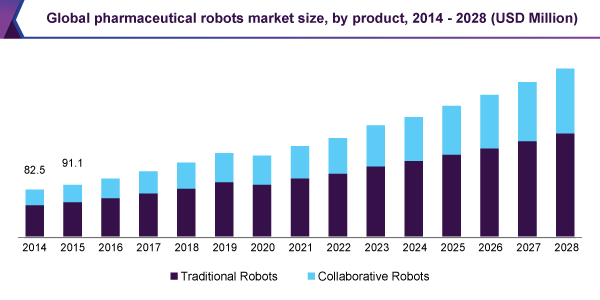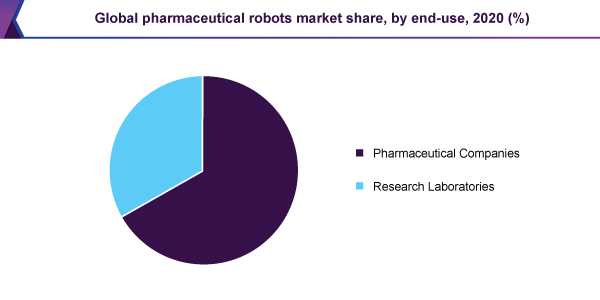- US: +1-408-610-2300
- Toll Free: +1-866-831-4085
- Become a Client
The global pharmaceutical robots market was prized by USD 142.9 million in 2020. It is estimated to witness 9.3% CAGR from 2021 to 2028.
The increasing requirement for the mechanization in manufacturing divisions, in addition to the elevated expenses of finding the fresh medicine, is considerably raising the need for the robotics in laboratories, clinical trials, and medicine invention, which is intended for the mechanizing the actions.

Besides, the major companies are presenting technically superior robotic equipments; this has additionally initiated the remarkable expansion of the market for pharmaceutical robots. Then again, the Covid-19 pandemic is more powering the acceptance of pharmaceutical robots to augment internal production, reduce manufacturing expenses, and conquer scarcity of the manual labor, by way of mechanization, rather than contracting out, to diminish threats of international supply chain after Covid-19.
In spite of the excessive original investment, required for the setting up, the continuing benefits of robots have prepared them a gainful mechanism in manufacturing procedure, causing a superior return on investment. This machinery is three to four times quicker than human being and is able to work for 24 hours.
By means of the increasing contest in the pharmaceutical business, medicinal manufacturing companies are transforming production procedure by way of robotic equipment. This technology has made possible the augmented production capability with an increasing capacity to present superiority products on lesser expenses. These abovementioned reasons are projected to increase the requirement for pharmaceutical robots, designed for the production procedures, in the near future.
The current Covid-19 pandemic has considerably amplified the alertness about the benefits of mechanization in the pharma segment, intended for rising as well as continuing manufacture with no compromising security or excellence. Sequentially, this is helping the enlargement of the market for pharmaceutical robots.
|
Pandemic Impact |
Post COVID Outlook |
|
The pharmaceutical robots market declined by 3.2% from 2019 to 2020, as per earlier projections the market was expected to be over USD 150 million in 2020. |
In 2021, the market will witness an increase of 11.8% from 2020, owing to the increasing demand for pharmaceutical products. |
|
COVID-19 resulted in delaying or deferring purchasing decisions and installations of pharmaceutical robots during the first half of 2020. |
Although the demand for many pharmaceutical products increased due to the ongoing pandemic, there is no significant increase in pharmaceutical manufacturing factories. This in turn will increase robot adoption. |
|
The emergence of COVID-19 has resulted in increased demand for testing and production of pharmaceuticals and increased awareness of robots. |
SCARA and collaborative robots are estimated to gain traction for research & development and performing high-accuracy high-volume tasks. |
Picking and packaging section held the major, 53.9% share of the pharmaceutical robots market, in 2020. It is expected to observe the highest expansion, throughout the forecast period. Robots make possible high-pitched accuracy in addition to good organization, over and above assists in administering the challenges of material handling.
Pick and place permit management of floor area, because of the necessity for restricted work covering, thus making possible the most advantageous use of the workplace. The pharmaceutical robots, utilized in laboratories assist in enhancing the effectiveness plus the excellence of the products, by way of greater throughput study. Therefore, this section is projected to observe substantial augmentation, during the near future.
The traditional robots section held the principal, 64.1% share of the pharmaceutical robot market, in 2020. The section is more subdivided into dual-arm, delta/parallel, articulated, Cartesian, and SCARA robots.
The related benefits of the implementation of these products in a variety of industrialized mechanization functions, such as the material handling actions like place and pick, palletizing, unloading, de palletizing, loading, product position, sorting, cutting, stacking, scribing, plus others are certainly adding to the expansion of the section.
The collaborative robots section is expected to observe the highest augmentation, throughout the forecast period. In contrast to the traditional robots, these equipments are reasonably priced and simpler to maintain and operate. Moreover, they are light in weight and needs bare minimum expertise to deal with. Sequentially, this is transforming manufacturing divisions.
In 2020, the pharmaceutical companies division held the leading, 66.9% share of the market. The division is anticipated to observe the highest expansion, during the forecast period. The pharmaceutical companies permit robot supported actions. It comprises internal laboratory functions, examination of the medicines along with packaging and picking. Besides, the rising use of robotics in pharmaceutical manufacturing is helping reproducibility and repeatability, at the same time dropping human mistakes.

On account of the rising use of robots in these amenities, the acceptance of pharmaceutical robots is additionally increasing between research laboratories. The mechanization of the laboratory has altered the R&D segment, in addition to made possible the fast examination of the test.
Moreover, the benefits presented by robots in laboratory functions, for example traceability, greater constancy, product reliability and better record-keeping, a growth in demand for well-organized workflow administration in research laboratories, plus the increase in the figure of plans being taken on by public and private companies to encourage mechanization are between the input factors, increasing the acceptance of pharmaceutical robots resolutions, thus helping the expansion of the market.
In 2020, Asia Pacific held the major, 41.9% share of the global pharmaceutical robots market and is expected to observe the highest enlargement, throughout the forecast period. This is credited to the existence of a huge number of native pharmaceutical companies, within the nations like Japan. Besides, consistent with the International Federation of Robotics (IFR), China was the major market for industrial robots, in 2019. In line with a piece of writing by Robotics & Automation, published in October 2020, China held 140,500 units which was the biggest global share of industrial robot induction. Essentially, this was the effect of a substantial growth in sales in China. Therefore, main pharmaceutical companies, having huge manufacturing divisions in these nations, are likely to boost the expansion of this local market.
The enlargement of the market in North America can be credited to a big number of robot inductions, within the region. In accordance with the IFR, in the U.S., the trade of 33,000 industrial robots had taken place, in 2017.
Therefore, North America has a considerably greater infiltration of pharmaceutical robots. As a result of a growth in the figure of pharmaceutical companies within the nation, this figure is likely to increase during the near future.
The IFR furthermore confirmed that North America is involved in increasing its pharmaceutical manufacturing divisions to contest with the international market, by means of the mechanization of its manufacturing amenities.
The manufacturing companies have implemented the diverse policies, intended for achieving the reasonable advantage in the market such as, discrimination of the product, rising funds for R&D activities, geographical growth, and partnerships with new companies.
|
Report Attribute |
Details |
|
Market size value in 2021 |
USD 159.8 million |
|
Revenue forecast in 2028 |
USD 297.4 million |
|
Growth Rate |
CAGR of 9.3% from 2021 to 2028 |
|
Base year for estimation |
2020 |
|
Historical data |
2014 - 2019 |
|
Forecast period |
2021 - 2028 |
|
Quantitative units |
Revenue in USD million and CAGR from 2021 to 2028 |
|
Report coverage |
Revenue, company ranking, competitive landscape, growth factors, and trends |
|
Segments covered |
Product, application, end-use, region |
|
Regional scope |
North America; Europe; Asia Pacific; Latin America; Middle East & Africa |
|
Country scope |
U.S.; Canada; U.K.; Germany; China; Japan; India; Brazil; Mexico; South Africa |
|
Key companies profiled |
ABB Ltd.; Kawasaki Heavy Industries Ltd.; Universal Robots A/S; FANUC America Corporation; Yaskawa Electric Corporation; Marchesini Group S.p.A; Seiko Epson Corporation; Denso Wave, Inc. |
|
Customization scope |
Free report customization (equivalent up to 8 analysts working days) with purchase. Addition or alteration to country, regional & segment scope. |
|
Pricing and purchase options |
Avail customized purchase options to meet your exact research needs. |
This report forecasts revenue growth at the global, regional, and country levels and provides an analysis of the latest industry trends and opportunities in each of the sub-segments from 2014 to 2028. For the purpose of this study, Million Insights, Inc. has segmented the global pharmaceutical robots market report on the basis of product, application, end-use, and region:
• Product Outlook (Revenue, USD Million, 2014 - 2028)
• Traditional Robots
• Articulated Robots
• SCARA Robots
• Delta/Parallel Robots
• Cartesian Robots
• Dual-arm Robots
• Collaborative Pharmaceutical Robots
• Application Outlook (Revenue, USD Million, 2014 - 2028)
• Picking and Packaging
• Inspection of Pharmaceutical Drugs
• Laboratory Applications
• End-use Outlook (Revenue, USD Million, 2014 - 2028)
• Pharmaceutical Companies
• Research Laboratories
• Regional Outlook (Revenue, USD Million, 2014 - 2028)
• North America
• U.S.
• Canada
• Europe
• Germany
• U.K.
• Asia Pacific
• Japan
• China
• India
• Latin America
• Brazil
• Mexico
• Middle East & Africa
• South Africa


Research Support Specialist, USA